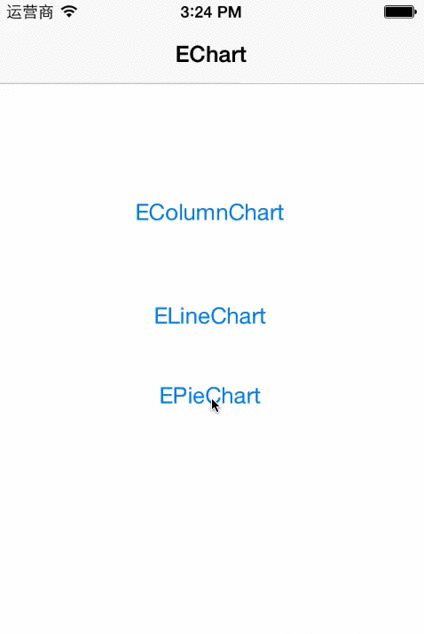#EChart A highly extendable, easy to use chart with event handling, animation supported.
##Test
Download and run the EChartDemo project is the best practice to know how to use EChart.
use CocoaPods with Podfile:
platform :ios, '7.0'
pod "EChart"or Download project here
And Drag /EChart/ folder into your project
EColumnChart as a example, all ECharts work in a similar way.
Import the head file:
#import "EColumnChart.h"
Make your ViewController adopts the EColumnChart's protocol:
@interface YourViewController : UIViewController <EColumnChartDelegate, EColumnChartDataSource>
Declare a EColumnChart instance:
@property (strong, nonatomic) EColumnChart *eColumnChart;
Give your EColumnChart a nice frame:
_eColumnChart = [[EColumnChart alloc] initWithFrame:CGRectMake(40, 100, 250, 200)];
Set EColumnChart's delegate and dataSource to your ViewController:
[_eColumnChart setDelegate:self];
[_eColumnChart setDataSource:self];
Add EColumnChart to wherever you want:
[self.view addSubview:_eColumnChart];
After setting up your EColumnChart, you may need to provide the data for the EColumnChart and you will be able to get events from EColumnChart as well.
If you were a expert with UITableView, you will be quite familiar with the way EColumnChart works. Because they work in a same way.
You need to implement every method in the EColumnChartDataSource
/** How many Columns are there in total.*/
- (NSInteger) numberOfColumnsInEColumnChart:(EColumnChart *) eColumnChart;
/** How many Columns should be presented on the screen each time*/
- (NSInteger) numberOfColumnsPresentedEveryTime:(EColumnChart *) eColumnChart;
/** The highest value among the whole chart*/
- (EColumnDataModel *) highestValueEColumnChart:(EColumnChart *) eColumnChart;
/** Value for each column*/
- (EColumnDataModel *) eColumnChart:(EColumnChart *) eColumnChart
valueForIndex:(NSInteger)index;
The implementation of the Delegate is according to your needs
/** When finger single taped the column*/
- (void) eColumnChart:(EColumnChart *) eColumnChart
didSelectColumn:(EColumn *) eColumn;
/** When finger enter specific column, this is dif from tap*/
- (void) eColumnChart:(EColumnChart *) eColumnChart
fingerDidEnterColumn:(EColumn *) eColumn;
/** When finger leaves certain column, will tell you which column you are leaving*/
- (void) eColumnChart:(EColumnChart *) eColumnChart
fingerDidLeaveColumn:(EColumn *) eColumn;
/** When finger leaves wherever in the chart, will trigger both if finger is leaving from a column */
- (void) fingerDidLeaveEColumnChart:(EColumnChart *)eColumnChart;
#License EChart is available under the Apache License. See the LICENSE file for more info..


